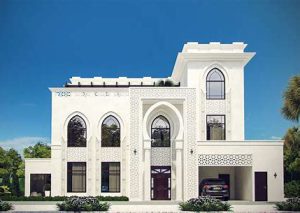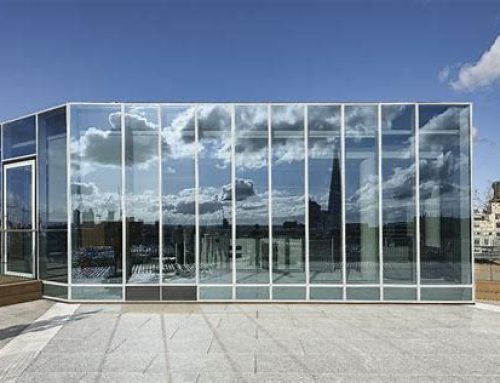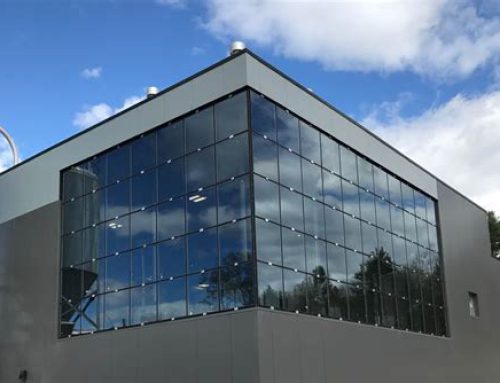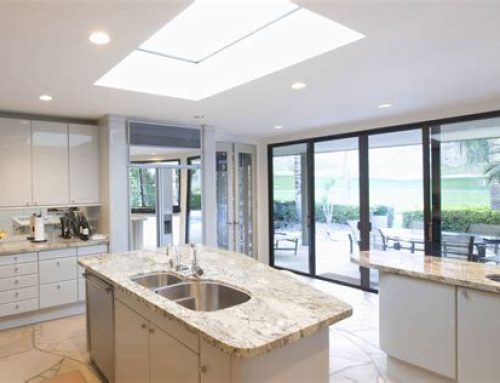Representing the facade of a modern villa building in the Middle East

Introduction:
Representing the facade of a modern villa building in the Middle East ,In the dynamic landscape of architectural design, the facade serves as the face of a building, often reflecting the essence and identity of its surroundings. Nowhere is this more evident than in the Middle East, where the juxtaposition of tradition and modernity inspires a unique architectural language. Modern villa buildings in this region epitomize sophistication, luxury, and innovation, with their facades showcasing a harmonious blend of cultural heritage and contemporary aesthetics.
Cultural Context: The Middle East boasts a rich architectural heritage, characterized by intricate geometric patterns, ornate motifs, and the extensive use of local materials such as limestone and marble. This legacy provides a profound influence on the design of modern villas, where architects often reinterpret traditional elements in a contemporary context. From the bustling streets of Dubai to the serene landscapes of Oman, each region offers its own architectural narrative, reflected in the diverse facades of villa buildings.
Innovative Materials and Techniques: Advancements in technology have revolutionized the way architects approach facade design, allowing for greater experimentation with materials and construction techniques. Glass, steel, and concrete are commonly employed to create sleek, minimalist exteriors, while traditional materials like stone and wood add warmth and texture. Sustainable practices such as passive shading and green walls are also gaining prominence, not only enhancing the aesthetic appeal but also reducing energy consumption and promoting environmental stewardship.
Symbolism and Identity: The facade of a modern villa serves as a canvas for self-expression, embodying the aspirations and values of its occupants. Whether it’s a towering skyscraper or a secluded desert retreat, each building tells a unique story through its design language. Symbolic elements such as arches, domes, and mashrabiya screens pay homage to the region’s cultural heritage, while contemporary features like cantilevered balconies and panoramic windows offer a glimpse into the future of architectural innovation.
Integration with the Surrounding Landscape: The Middle East is renowned for its breathtaking natural landscapes, from the rolling dunes of the desert to the azure waters of the Persian Gulf. Architects often capitalize on these stunning vistas by seamlessly integrating the villa’s facade with its surroundings. Floor-to-ceiling windows frame panoramic views, blurring the boundaries between indoor and outdoor spaces, while landscaped gardens and water features create a sense of tranquility and serenity.
Architectural Iconography: In cities like Doha and Riyadh, where skyline dominance is a testament to economic prowess, modern villa buildings vie for attention with iconic landmarks and skyscrapers. Architects strive to create visually striking facades that stand out amidst the urban sprawl, employing bold shapes, striking colors, and innovative lighting schemes to captivate the viewer’s imagination. These architectural masterpieces not only elevate the skyline but also serve as symbols of progress and prosperity.
Evoking a Sense of Luxury and Comfort:
Beyond the architectural prowess and cultural significance, the facade of a modern villa in the Middle East also serves to evoke a sense of luxury and comfort. In a region where opulence is often synonymous with lifestyle, every detail of the exterior design is meticulously curated to reflect sophistication and extravagance. From grand entrances adorned with intricate carvings to expansive terraces overlooking private pools, each element of the facade contributes to an ambiance of exclusivity and indulgence.
Materials such as marble, granite, and onyx are favored for their timeless elegance and luxurious appeal. Exquisite detailing in the form of intricate mosaics, handcrafted metalwork, and custom-designed lighting fixtures further elevate the aesthetic, creating a visual symphony of texture, color, and light. Even the landscaping surrounding the villa is carefully orchestrated to complement the architectural composition, with lush gardens, cascading water features, and sculptural elements adding to the sense of grandeur.
Moreover, the facade is designed not only to impress but also to provide a sanctuary from the harsh climate of the region. Innovative shading systems, such as brise-soleil and louvered screens, are strategically integrated into the design to mitigate solar heat gain while maximizing natural light and ventilation. High-performance glazing and thermal insulation ensure optimal comfort year-round, allowing residents to enjoy the lavish surroundings without compromising on energy efficiency or sustainability.
Embracing Modernity While Preserving Tradition:
In the pursuit of modernity, it is crucial to strike a delicate balance between innovation and tradition. While the facade of a modern villa may exude contemporary flair, it often pays homage to the rich cultural heritage of the Middle East. Architectural elements inspired by Islamic art and design, such as intricate geometric patterns, arabesque motifs, and muqarnas vaults, are seamlessly integrated into the facade, creating a sense of continuity with the past.
At the same time, architects are keen to embrace cutting-edge technologies and design principles to push the boundaries of creativity and functionality. Parametric modeling, digital fabrication, and Building Information Modeling (BIM) enable architects to explore complex geometries and structural configurations, resulting in facades that are as visually captivating as they are structurally sound. Sustainable design practices, including passive solar design, rainwater harvesting, and green roofs, further underscore the commitment to environmental stewardship and responsible development.
In conclusion:
the facade of a modern villa in the Middle East is a testament to the region’s rich architectural heritage, technological innovation, and uncompromising pursuit of luxury and comfort. It serves as a canvas for self-expression, cultural expression, and environmental responsibility, embodying the aspirations and values of its inhabitants. As the Middle East continues to evolve and redefine itself on the global stage, the facade of its modern villas will undoubtedly remain a source of inspiration and admiration for generations to come.





Leave A Comment